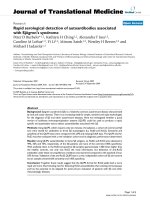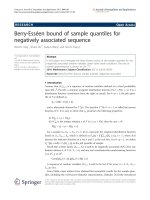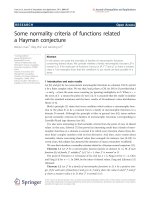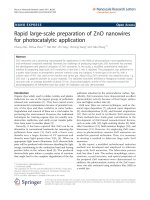Báo cáo hóa học: " Rapid large-scale preparation of ZnO nanowires for photocatalytic application" docx
Bạn đang xem bản rút gọn của tài liệu. Xem và tải ngay bản đầy đủ của tài liệu tại đây (1.88 MB, 5 trang )
NANO EXPRESS Open Access
Rapid large-scale preparation of ZnO nanowires
for photocatalytic application
Chunyu Ma
1
, Zhihua Zhou
1,2†
, Hao Wei
1
, Zhi Yang
1
, Zhiming Wang
2
and Yafei Zhang
1*†
Abstract
ZnO nanowires are a promising nanomaterial for applications in the fields of photocatalysis, nano-optoelectronics,
and reinforced composite materials. However, the challenge of producing large-scale ZnO nanowires has stunted
the development and practical utilization of ZnO nanowires. In this study, a modified carbothermal reduction
method for preparing large-scale ZnO nanowires in less than 5 min is reported. The preparation was performed in
a quartz tube furnace at atmospheric pressure without using any catalysts. A mixed gas of air and N
2
with a
volume ratio of 45:1 was use d as the reactive and carrier gas. About 0.8 g ZnO nanowires was obtained using 1 g
ZnO and 1 g graphite powder as source materials. The obtained nanowires exhibited a hexagonal wurtzite crystal
structure with an average diameter of about 33 nm. Good photocatalytic activity of the nanowires toward the
photodegradation of methylene blue dye under UV irradiation was also demonstrated.
Introduction
Organic dyes widely used in rubber, textiles, and plastics
industries are one of the largest groups of pollutants
released into wastewaters [1]. They have caused severe
environmental contamination because of potential toxi-
city of the dyes and their visibility in water bodies.
Degradation and removal of them are a vital matter for
protecting the environment. However, the traditional
techniques for treating organic dyes are usually non-
destructive, ineffe ctive, and costly or just transfer pollu-
tions from water to another phase [2].
Recently, it has been reported that ZnO can be an
alternative to conventional treatments for removing dye
pollutants from water [3]. ZnO, with a lower cost,
absorbs over a larger fraction of UV spectrum and
absorbs more light quanta than TiO
2
[4]. When an
appropriate light source illuminates ZnO, electron/hole
pairs will be produced wit h electrons absorbing the light
energy, transitioning to the conduction band and leaving
positive holes in the valence band [5]. The produced
electron/hole pairs induce a complex series of reactions
that might lead to the complete degradation of the dye
pollutants adsorbed on the semiconductor surface. Spe-
cifically, ZnO nanowires have demonstrated excellent
photocatalytic activity because of their larger surface
area and higher surface state [6].
Until now, t here are various techniques, such as che-
mical vapor deposition [7], physical vapor deposition
[8], electrodeposition [9,10], and thermal evaporation
[11] that can be used to synthesize ZnO nanowires.
These methods have made great contribution to the
development of ZnO-based nanoelectronic devices,
such as solar cells [12], light-emitting diodes [8], field-
effect transistors [13], f ield-emission displays [14], and
biosensors [15]. However, for employing ZnO nano-
wires as photocatalysts, massive ZnO nanowires are
needed for practical utilization. Thus, it is necessary
to develop a method to fabricate large-scale ZnO
nanowires.
In this report, a modified carbothermal reduction
method was developed and employed to fabricate
large-scale ZnO nanowires. The fabrication process
took less than 5 min. The surface morphology, micro-
structure, crystal structure, and optical properties of
the prepared ZnO nanowires were characterized. In
addition, the photocatalytic activity of the ZnO nano-
wires was also evaluated using methylene blue (MB) as
a model dye.
* Correspondence:
† Contributed equally
1
Key Laboratory for Thin Film and Microfabrication of Ministry of Education,
Research Institute of Micro/Nano Science and Technology, Shang hai Jiao
tong University, Shanghai 200240, China
Full list of author information is available at the end of the article
Ma et al. Nanoscale Research Letters 2011, 6:536
/>© 2011 Ma et al; licensee Springer. This is an Open Access article distributed under the terms of the Creative Commons Attribution
License ( which permits unrestricted use, distribution, and reproduction in any medium,
provided the original work is properly cited.
Experimental
Preparation of ZnO nanowires
A quartz tube furnace with an inner diameter of 7.5 cm
was first heated to 1150°C. Then, the furnace was
purged with a mixed gas of air (0.1 L/min) and N
2
gas
(4.5 L/min) continuously. Subsequently, mixtures of
ZnO (Sinopharm Chemical Reagent Co., Ltd) and gra-
phite (325 mesh) powder (2 g) with a weight ratio of
1:1, which was grounded in an agate morta r beforehand,
were transferred to a quartz boat, and then the boat was
placed in the middle of the furnace. After about 1 min,
white snowflake-like product was carried out by the car-
rier gas. A 5000-mL flask, covered at the downstream of
the quartz tube furnace, was used to collect the pre-
pared product. The total reaction time was about 5 min.
A white layer of products was deposited on the inner
surface of the flask lastly. The weight of the obtained
ZnO nanowires was about 0.8 g, which is 80% of the
source ZnO powder.
Sample characterizations
The crystal structure of the prepared ZnO nanowire s
was analyzed using X-ray diffraction (XRD, D/max-
2200/PC, Rigaku). The morphology and microstructure
of the nanowires were characterized using scanning
electron microscopy (SEM, Ultra 55, Carl Zeiss) and
transmission electron microscopy (TEM, JEM-2100,
JEOL). The chemical composition of the nanowires was
analyzed by the energy dispersive X-rays spectroscopy
(EDS) with the SEM. The Raman signals of the ZnO
nanowires were recorded using an Ar
+
ion laser as the
excitation (514.5 nm) at room temperature (French Lab-
rum-HR). The pho toluminescence (PL) spectra of the
ZnO nanowires were performed using a He-Cd laser
line of 325 nm as an excitation source (Jobin Yvon Lab-
RAM HR 800UV).
Photocatalytic studies
ThephotocatalyticactivityofthepreparedZnOnano-
wires was studied by using MB as a model dye. The
prepared ZnO nanowires (20 mg) were dispersed in
100 mL of MB aqueous solution (10 mg/L). Before
irradiating, the above mixture solution was sonicated
for 30 min for establishing absorption-desorption equi-
librium. A 1000 W xenon lamp was used as the light
source, and placed at about 120 cm above of the mix-
ture solution. The intensity of UV part between the
wavelengths range of 320-400 nm was measured to be
about 8 mW/cm
2
. The exp erim ents were performed for
60 min, and samples were taken every other 10 min.
The concentration of MB was mo nitored by measuring
the absorbance of the supernatant at 665 nm using a
UNICO UV-2102 spectrometer. A c ontrol test of MB
photodegradation in absence of ZnO nanowires was
also performed.
Results and discussion
Figure 1a shows a photographic image of the prepared
ZnO nanowires collected in a 50 00-mL flask using the
mixture powder with 2.0 g as a source material. The
ZnO nanowires formed a white cotton-like semi-
transparent thin film on the inner wall of the flask. A
high yield (0.8 g ZnO nanowires) of the product was
achieved. Figure 1b presents a typical SEM image of the
ZnO nanowires. It shows a general view of the morphol-
ogy of the nanowires. The ZnO nano wires are observed
as entangled and curved wire-like structure. The edges
of the ZnO nanowires are smooth.
Size uniformity is an important index to evaluate the
quality of n anomaterials. Here, the size uniformity of
the prepared ZnO nanowires was investigated by study-
ing the diameter distribution of the nanowire s. The dia-
meters of the prepared ZnO nanowires were extracted
from 200 nanowires in several SEM images. The dia-
meter distribution histogram is shown in Figure 1c. It
can be seen that the diameters of most of the nanowires
ranged from 30 to 40 nm. The black solid line is the
corresponding Gaussian line-fitting. It s hows that the
average diameter of these nanowires was about 33 nm.
The detailed microstructure of the ZnO nanowires
was further characterized using TEM. Figure 1d shows a
typical low-magnification TEM image of the prepared
ZnO nanowires, revealing the representative morphology
of the ZnO nanowires. It shows s everal straight and
smooth nanowires with no secondary growth or extra
structural features. Inset in Figure 1d shows a typical
electron diffraction pattern of a single ZnO nanowire,
suggesting the polycrystalline nature of the nanowires.
An HRTEM image taken from a single nanowire is pre-
sented in Figure 1e. The clear lattice fringes in the
HRTEM image indicate that the nanowire had a high
degree of crystallinity and no amorphous materials
existed at the interface. The lattice spacing is measured
to be approximately 0.52 nm, which agrees well with the
spacing of the (002) planes of the wurtzite ZnO struc-
ture. The TEM re sults suggest that the ZnO nanowires
were structurally uniform polycrystalline nanowires.
Raman scattering is sensitive to the microstructure of
nanomaterials. It was used here to further study the
structure of the ZnO nanowires. Figure 2 shows a typical
room temperature Raman spectrum of the ZnO nano-
wires. The spectrum exhibited two usual modes in ZnO,
including 333 (E
2
(high)-E
2
(low) [16]) and 437 cm
-1
(E
2
(high)), which is relatively weak in intensity [17].
Another noticeably A
1
(LO) mode at about 573 cm
-1
[18]
is also observed, which is attributed to the electric
Ma et al. Nanoscale Research Letters 2011, 6:536
/>Page 2 of 5
field-induced Raman scattering [19], revealing the high
quality of the ZnO nanowires.
The crystal structure of the ZnO nanowires was mea-
sured by XRD analysis. Figure 3 shows a typical XRD
pattern o f the ZnO nanow ires recorded from 10 °to 80°.
The diffraction peaks are exactly indexed to the hexag o-
nal wurtzite ZnO phase (JCPDS 65-3411) with cell con-
stants of a =3.24Åandc = 5.19 Å. Diffraction peaks
associated with zinc or carbon were not detected in the
Figure 1 Morphology characterization of the prepared ZnO nanowires. At (a) photographic image, (b) typical SEM image, (c) the diameter
distribution histograms, (d) TEM image, and (e) HRTEM image. Inset is a typical electron diffraction pattern of a single ZnO nanowire.
Figure 2 Raman spectrum of the prepared ZnO nanowires. Figure 3 XRD pattern of the prepared ZnO nanowires.
Ma et al. Nanoscale Research Letters 2011, 6:536
/>Page 3 of 5
prepared sample. The broadening of ZnO peaks is due
to the small nanowire size.
Optical properties of functional nanomateria ls are of
importance considering further applications in nanoelec-
tronic devices [20] . Therefore, the optical properties of
the prepared ZnO nanowires were further investigated
by PL spectroscopy. Figure 4 presents the PL spectrum
of the prepared ZnO nano wires. Two emitting bands,
including a strong ultraviolet emission at about 386 nm
and a very week green band (450-550 nm), were
observed. The strong ultraviolet emission is contributed
to the near band edge emission of the wide bandgap
ZnO. The green band emission is due to the singly
ionized oxygen vacancy in ZnO and is an effect of the
recombination of a photogenerated hole with the single
ionized charge state of defects [21]. The intensi ty of the
green luminescence is proportional to the amount of
singly ionized oxygen vacancies. Here, the almost negli-
gible g reen band indicates that there is a very low con-
centration of oxygen vacancies in the prepared ZnO
nanowires.
ZnO has been con sidered to be a promising photoca-
talysts for the degradation of organic contaminant
[2,22,23]. The photocatalytic activity of the ZnO nano-
wires was evaluated usin g MB as a model dye. Figu re 5a
shows the time-dependent absorption spectra of MB
degradation over ZnO nanowires under UV irradiation.
It can be seen that the absorbance peak at 665 nm is
reduced significantly, which indicated the degradation of
MB molec ules. Figure 5b shows curves of MB d egraded
with and without using the prepar ed ZnO nanowires as
photocatalysts. It w as found that the self-degradation of
MB without using photocatalysts can be neglected. The
concentration of MB decreased gradually with increasing
exposure time in the p resence of ZnO nanowires. Inset
in Figure 5b shows the corresponding ln(C
0
/C)versus
time curve. The curve shows a linear relationship with
the irradiation time, indicating that the photodegrada-
tion of MB over the prepared ZnO nanowires proceeded
through the pseudo-first-order kinetic reaction. The
value of k, which is the photodegradation rate constant,
was fitted to be about 1.86 h
-1
.
Conclusions
In summary, we have demonstrated a rapid and catalyst-
free technique for preparing large-scale ZnO nanowires.
Figure 4 Room temperature photoluminescence spectrum of
the prepared ZnO nanowires excited at 325 nm.
Figure 5 Photocatalytic activity of the ZnO nanowires toward
the photodegradation of methylene blue (MB). At (a) Time-
dependent UV-Vis absorbance spectra of the MB solution using the
prepared ZnO nanowires as photocatalysts and (b) Curves of the
degradation rate of the MB dye and UV irradiation time with and
without the photocatalyst of the prepared ZnO nanowires (C
0
is the
initial concentration of MB, C is the reaction concentration of MB at
time t). Inset is the ln(C
0
/C) versus time curve of photodegradation
of MB in the presence of the prepared ZnO nanowires.
Ma et al. Nanoscale Research Letters 2011, 6:536
/>Page 4 of 5
The technique is based on a modified carbothermal
reduction method. ZnO nanowires prepared by this
technique had a hexagonal wurtzite crystal structure,
with an average diameter of 33.5 nm. Microstructure
and optical properties characterization results indicated
that the ZnO nanowires had a polycrystal line structure
with a low concentration of oxygen vacancies. Photoca-
talytic activity evaluation measurements showed that the
ZnO nanowires had a photodegradation rate constant of
1.86 h
-1
to MB dye under UV irradiation.
Acknowledgements
This study was primarily supported by the National Nature Science
Foundation of China Nos. 50730008, 50902092, and 61006002, and the
Shanghai Science and Technology Grant No. 052nm02000 and 09JC1407400.
Author details
1
Key Laboratory for Thin Film and Microfabrication of Ministry of Education,
Research Institute of Micro/Nano Science and Technology, Shang hai Jiao
tong University, Shanghai 200240, China
2
State Key Laboratory of Electronic
Thin Film and Integrated Devices, Universi ty of Electronic Science and
Technology of China, Chengdu 610054, China
Authors’ contributions
CYM prepared the manuscript and participated in measurements. ZHZ
performed the experiment. ZY helped in technical support for experiments.
HW participated in measurements. ZMW provided useful suggestions. YFZ
supervised all of the study. All the authors discussed the results and
approved the final manuscript.
Competing interests
The authors declare that they have no competing interests.
Received: 31 August 2011 Accepted: 3 October 2011
Published: 3 October 2011
References
1. Han F, Kambala VSR, Srinivasan M, Rajarathnam D, Naidu R: Tailored
titanium dioxide photocatalysts for the degradation of organic dyes in
wastewater treatment: a review. Appl Catal A: Gen 2009, 359:25-40.
2. Yang L-Y, Dong S-Y, Sun J-H, Feng J-L, Wu Q-H, Sun S-P: Microwave-
assisted preparation, characterization and photocatalytic properties of a
dumbbell-shaped ZnO photocatalyst. J Hazard Mater 2010, 179:438-443.
3. Zhang M, An T, Liu X, Hu X, Sheng G, Fu J: Preparation of a high-activity
ZnO/TiO
2
photocatalyst via homogeneous hydrolysis method with low
temperature crystallization. Mater Lett 2010, 64:1883-1886.
4. Qu J, Luo C, Cong Q: Synthesis of multi-walled carbon nanotubes/ZnO
nanocomposites using absorbent cotton. Nano-Micro Lett 2011, 3:115-120.
5. Bao J, Shalish I, Su Z, Gurwitz R, Capasso F, Wang X, Ren Z: Photoinduced
oxygen release and persistent photoconductivity in ZnO nanowires.
Nanoscale Res Lett 2011, 6:404.
6. Chen H, Wu X, Gong L, Ye C, Qu F, Shen G: Hydrothermally grown ZnO
micro/nanotube arrays and their properties. Nanoscale Res Lett 2010,
5:570-575.
7. Zhang D, Chava S, Berven C, Lee SK, Devitt R, Katkanant V: Experimental
study of electrical properties of ZnO nanowire random networks for gas
sensing and electronic devices. Appl Phys A Mater 2010, 100:145-150.
8. Zhu G, Yang R, Wang S, Wang ZL: Flexible high-output nanogenerator
based on lateral ZnO nanowire array. Nano Lett 2010, 10:3151-3155.
9. Zhang Z, Meng GW, Xu QL, Hu YM, Wu Q, Hu Z: Aligned ZnO nanorods
with tunable size and field emission on native Si substrate achieved via
simple electrodeposition. J Phys Chem C 2010, 114:189-193.
10. Pauporté T, Bataille G, Joulaud L, Vermersch FJ: Well-aligned ZnO nanowire
arrays prepared by seed-layer-free electrodeposition and their cassie-
wenzel transition after hydrophobization. J Phys Chem C 2010,
114:194-202.
11. Mute A, Peres M, Peiris TC, Lourenço AC, Jensen LR, Monteiro T: Structural
and optical characterization of ZnO nanowires grown on alumina by
thermal evaporation method. J Nanosci Nanotechnol 2010, 10:2669-2673.
12. Hossain MF, Takahashi T: Microstructured ZnO photoelectrode grown on
the sputter-deposited ZnO passivating-layer for improving the
photovoltaic performances. Mater Chem Phys 124:940-945.
13. Fleischhaker F, Wloka V, Hennig I: ZnO based field-effect transistors (FETs):
solution-processable at low temperatures on flexible substrates. J Mater
Chem 2010, 20:6622-6625.
14. Park S-B, Kim B-G, Kim J-Y, Jung T-H, Lim D-G, Park J-H, Park J-G: Field-
emission properties of patterned ZnO nanowires on 2.5D MEMS
substrate. Appl Phys A Mater Sci Process 2010, 102:169-172.
15. Choi A, Kim K, Jung HI, Lee SY: ZnO nanowire biosensors for detection of
biomolecular interactions in enhancement mode. Sensor Actuat B Chem
2010, 148 :577-582.
16. Umar A, Karunagaran B, Suh E-K, Hahn YB: Structural and optical
properties of single-crystalline ZnO nanorods grown on silicon by
thermal evaporation. Nanotechnology 2006, 17:4072.
17. Alim KA, Fonoberov VA, Balandin AA:
Origin of the optical phonon
frequency shifts in ZnO quantum dots. Appl Phys Lett 2005, 86:053103.
18. Kim HW, Kebede MA, Kim HS: Structural, Raman, and photoluminescence
characteristics of ZnO nanowires coated with Al-doped ZnO shell layers.
Curr Appl Phys 2010, 10:60-63.
19. Tzolov M, Tzenov N, Dimova-Malinovska D, Kalitzova M, Pizzuto C, Vitali G,
Zollo G, Ivanov I: Vibrational properties and structure of undoped and Al-
doped ZnO films deposited by RF magnetron sputtering. Thin Solid Films
2000, 379 :28-36.
20. Greyson E, Babayan Y, Odom T: Directed growth of ordered arrays of
small-diameter ZnO nanowires. Adv Mater 2004, 16:1348-1352.
21. Vanheusden K, Warren WL, Seager CH, Tallant DR, Voigt JA, Gnade BE:
Mechanisms behind green photoluminescence in ZnO phosphor
powders. J Appl Phys 1996, 79:7983-7990.
22. Mekasuwandumrong O, Pawinrat P, Praserthdam P, Panpranot J: Effects of
synthesis conditions and annealing post-treatment on the
photocatalytic activities of ZnO nanoparticles in the degradation of
methylene blue dye. Chem Eng J 2010, 164:77-84.
23. Xie W, Li Y, Sun W, Huang J, Xie H, Zhao X: Surface modification of ZnO
with Ag improves its photocatalytic efficiency and photostability.
J Photochem Photobiol A 2010, 216:149-155.
doi:10.1186/1556-276X-6-536
Cite this article as: Ma et al.: Rapid large-scale preparation of ZnO
nanowires for photocatalytic applicat ion. Nanoscale Research Letters 2011
6:536.
Submit your manuscript to a
journal and benefi t from:
7 Convenient online submission
7 Rigorous peer review
7 Immediate publication on acceptance
7 Open access: articles freely available online
7 High visibility within the fi eld
7 Retaining the copyright to your article
Submit your next manuscript at 7 springeropen.com
Ma et al. Nanoscale Research Letters 2011, 6:536
/>Page 5 of 5









